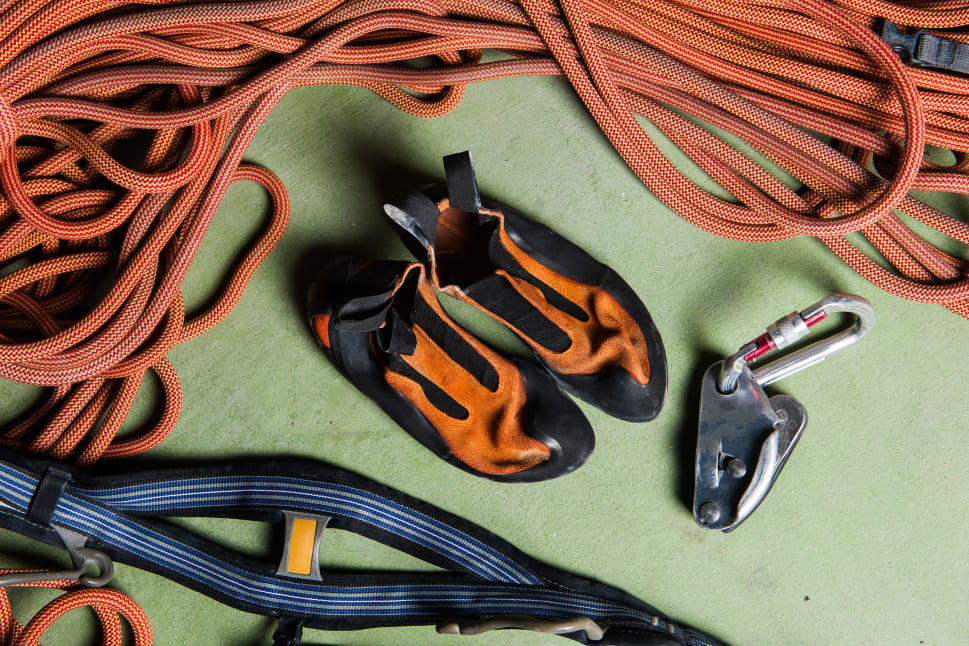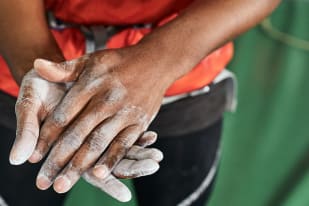What You Need to Climb Safely and Effectively
This piece explores the essential gear required for rock climbing and bouldering, focusing on the equipment that ensures safety and supports performance. From shoes to ropes to helmets, each item contributes to the overall climbing experience. This resource breaks down the purpose and importance of each piece of gear, with a focus on climbing in Kamloops, BC, a region known for its varied climbing spots.
Climbing Shoes: Where Every Ascent Begins
Climbing shoes are the first piece of gear every climber secures. They provide grip and precision, allowing climbers to use small footholds and edges that regular footwear cannot manage. The rubber soles are designed to stick to both indoor holds and the rocky surfaces found around Kamloops.
Shoes vary by style. Neutral shoes offer comfort for beginners and all-day climbs. Moderate shoes, with a slight downturn, support technical movements. Aggressive shoes feature a strong downturn, making them suitable for advanced climbers tackling overhangs and steep routes. A proper fit is critical; shoes must feel snug without causing pain. Major Canadian retailers, including MEC and La Sportiva Canada, offer a wide selection suitable for Kamloops climbers.
Harnesses: Staying Connected
A harness keeps the climber attached to the rope and distributes weight evenly during a fall. It includes a waistbelt, leg loops, gear loops for holding equipment, and a belay loop for attaching to the rope system.
Climbers choose harnesses based on their climbing style. Sport and gym harnesses are lighter and more streamlined, while trad and alpine harnesses feature extra gear loops and adjustable leg loops. Fit and comfort remain top priorities. In Kamloops, harnesses from brands like Petzl and Black Diamond are widely available at local retailers and climbing gyms.
Helmets: Essential Head Protection
Helmets shield climbers from falling rocks and impacts sustained during falls. Two main types exist: hardshell helmets, which offer durability and protection from rockfall, and foam helmets, which are lighter and better suited for sport climbing and longer routes where weight matters.
Key features include ventilation for comfort and a secure, adjustable fit. Climbers should look for certifications from organizations such as UIAA and CE. Models like the Petzl Boreo and Black Diamond Vision are commonly used by Kamloops climbers who explore the area's outdoor routes.
Ropes: The Safety Line
Climbing ropes are classified as either dynamic or static. Dynamic ropes stretch to absorb the energy of a fall, protecting both the climber and the anchor system. Static ropes, with minimal stretch, are used for rappelling, hauling, and fixed lines.
Ropes vary in diameter and length. Thinner ropes are suited to sport climbing, while thicker ropes are preferred for top-rope setups and trad climbing. Common lengths range from 60 to 80 metres, suitable for many of the routes found around Kamloops. Proper care, including regular inspections and storage away from sunlight and chemicals, extends a rope’s lifespan.
Belay Devices: Controlling the Climb
Belay devices control the rope during belaying and rappelling. Tube-style devices are versatile and suit most climbing situations. Assisted-braking devices provide extra stopping power, reducing the physical effort required by the belayer.
The choice of belay device depends on the climber’s experience and climbing type. Popular options in Kamloops include the Black Diamond ATC and the Petzl GriGri, available through both local retailers and climbing gyms.
Carabiners and Quickdraws: Linking the System
Carabiners connect different parts of the climbing system. Locking carabiners secure belay devices and anchors, while non-locking carabiners are used where quick clipping is needed.
Quickdraws consist of two carabiners linked by a strong, narrow sling. They allow the rope to run freely through protection points while reducing rope drag. Strength ratings and gate mechanisms are key selection factors. Climbers in Kamloops often choose lightweight options for long routes and more durable options for working projects.
Chalk and Chalk Bags: Maintaining Grip
Climbers use chalk to absorb sweat and improve grip. It comes in loose form, chalk balls, or liquid. Chalk balls and liquid chalk reduce airborne particles, making them suitable for indoor gyms such as Cliffside Climbing Gym in Kamloops.
Chalk bags attach to the climber’s waist or sit on the ground for bouldering. Some bags include brush holders for cleaning holds. Canadian retailers offer a range of chalk and bags suited to both indoor and outdoor climbing.
Crash Pads: Ground Protection for Boulderers
Crash pads cushion falls during bouldering. Two main styles are available. Taco-style pads have continuous foam and fold without hinges. Hinge-style pads fold flat but may have a gap in the centre.
Key factors to consider include size, thickness, portability, and durability. Popular choices include the Black Diamond Mondo and the Mad Rock R3. Straps and handles make transportation to outdoor bouldering locations around Kamloops easier, such as the sites near Peterson Creek Park and Kenna Cartwright Park.
Additional Essentials: Supporting Safety and Performance
Traditional climbers use cams and nuts to secure ropes to the rock. Hexes offer a simpler form of passive protection. Slings and runners extend placements and reduce rope drag.
Prusik cords assist with self-rescue and rope ascension. Climbing tape protects skin and supports tendons. Brushes keep holds clean, improving grip and reducing wear on climbing shoes.
Other useful gear includes approach shoes for reaching climbing areas, headlamps for early starts or late finishes, and backpacks designed to carry all necessary equipment comfortably. These are especially useful for climbers accessing outdoor routes around Kamloops where approaches may vary in length and terrain.
Indoor vs. Outdoor Climbing: Gear Differences
Indoor climbers often rent gear such as shoes, harnesses, and belay devices at gyms. For regular indoor climbing at Kamloops facilities, purchasing personal gear ensures a better fit and hygiene.
Outdoor climbing requires additional equipment, including ropes, helmets, and protection gear. Climbers transitioning from gyms to outdoor crags near Kamloops need to expand their gear and develop skills suited to real rock environments.
Kamloops Climbing Resources and Communities
Climbers can connect with local gyms such as Cliffside Climbing Gym. Outdoor destinations around Kamloops, including the Kamloops Crags and the rocky faces near Kenna Cartwright Park, offer a range of climbing opportunities.
Organizations like the Kamloops Climbing Association and provincial groups provide courses, certifications, and community events.
Conclusion: Equipped for the Ascent
The right gear supports safety and success in climbing. From climbing shoes to crash pads, each item plays a role in protecting the climber and enhancing the overall experience. A thoughtful approach to gear selection, combined with proper training and knowledge of Kamloops' climbing resources, prepares climbers for the challenges and rewards of the sport.



